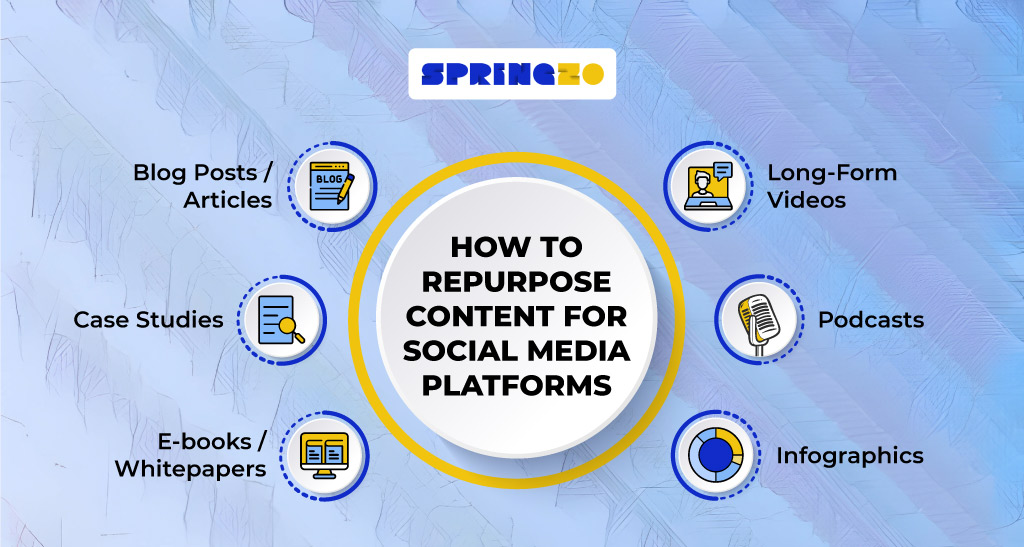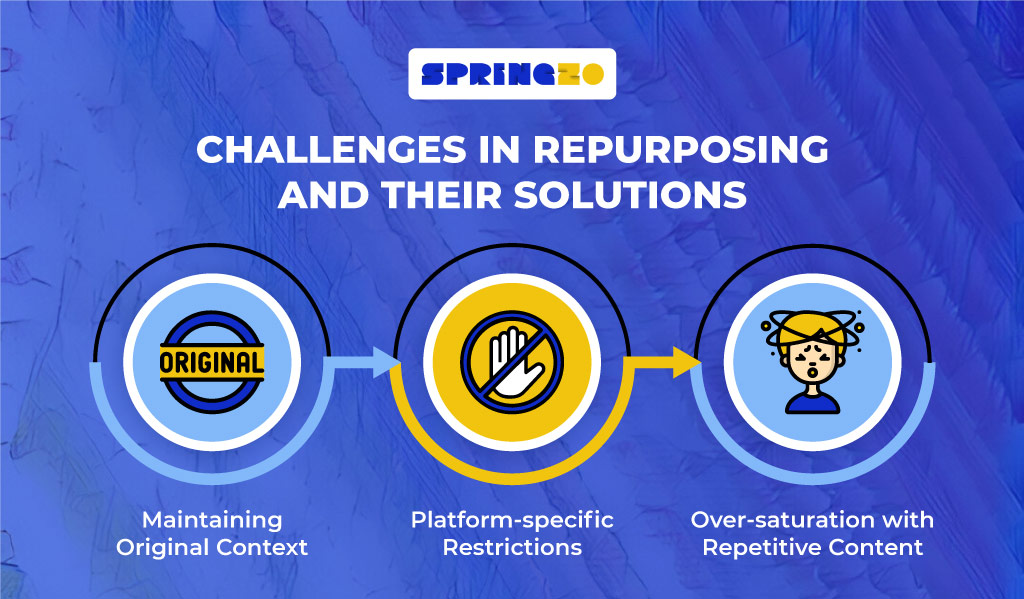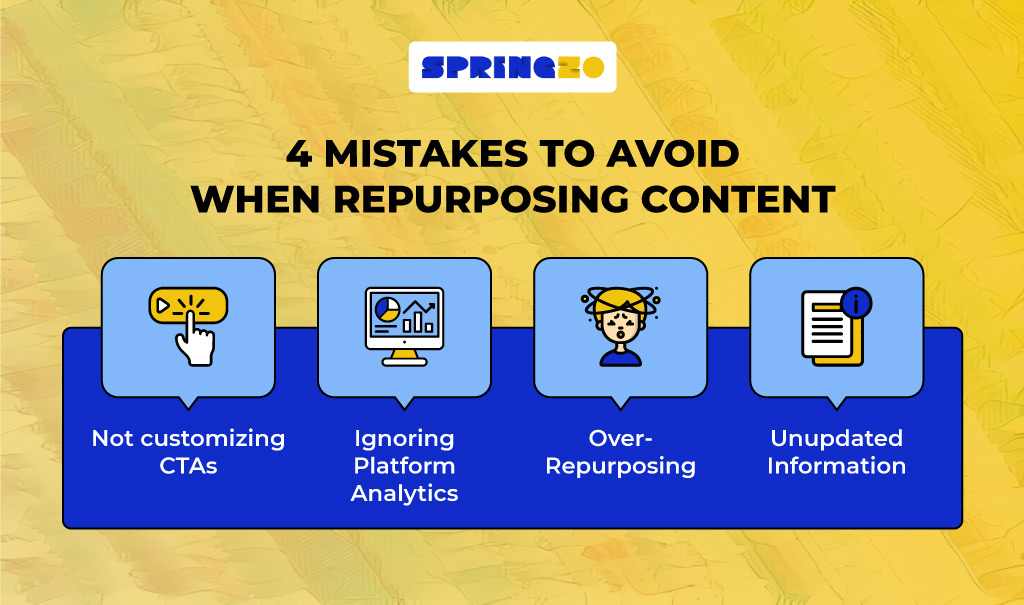Today, mastering the art of content repurposing is pivotal. Why? Simply put, understanding how to repurpose content for social media is a strategic move that elevates a brand’s online presence.
According to a recent report by HubSpot, 90% of social media marketers believe that building an active online community is pivotal for a successful social media strategy in 2023.
Building an active online community starts with posting valuable content regularly and consistently. But that can take a lot of time and resources.
Enter repurposing! It’s more than just recycling; it’s about amplifying your message across different platforms, tailoring it to suit diverse audiences, and maximizing every ounce of effort you’ve invested in creating the original content.
In this comprehensive blog post, we discuss how to repurpose content for social media with step-by-step guidelines.
How to Repurpose Content for Social Media: The Strategic Value
The value of this practice is to enhance the impact of the existing content by 3x. Let’s explore how:
Reach
In terms of reach, repurposing amplifies your voice. Not every potential customer is on the same platform or consumes content in the same manner. By reshaping and repositioning your content, you cast a wider net, ensuring that your message resonates with a broader audience.
Engagement
Different social media platforms have unique user behaviors. A well-researched article might perform exceptionally on your website, but its key points, when transformed into an Instagram carousel or an X thread, could spark more interactions, comments, and shares. By repurposing, you’re speaking the language of each platform and its users.
ROI
Lastly, let’s talk ROI. In the business world, time is money. The hours spent crafting that comprehensive webinar or in-depth guide? They should yield more than a one-off engagement.
By understanding how to repurpose content for social media, brands can extract maximum value from their initial investment, driving traffic, conversions, and brand loyalty across multiple channels with a single piece of content.
In 2023, 24% of consumers aged 18-54 search for brands on social media more frequently than search engines. This statistic rises significantly for Gen Z, with 36% prioritizing social media for brand searches over traditional search engines.
So tapping into this and being present and relevant on social media is extremely important.
Now, as the first step, let’s learn how to identify what content to repurpose.
Pre-repurposing Analysis
Navigating how to repurpose content for social media starts with a thorough analysis of what’s already in your arsenal. Let’s break down this preliminary phase into actionable steps.
Step 1: Audit Your Current Content Inventory
The bedrock of any successful repurposing strategy begins with a meticulous content audit. Tools like Google Analytics and SEMrush can provide insightful metrics about your content’s performance. By sifting through these tools, you can pinpoint which pieces of content resonated most with your audience, what generated the highest traffic, and where visitors lingered the longest.
This forms a solid foundation for understanding how to repurpose content for social media, as it illuminates the narratives or information your audience finds most compelling.
Step 2: Identify Top-Performing Content
With your audit data, your next objective is spotlighting the top performers. These are your gold mines – articles, videos, infographics, or podcasts that have proven their worth regarding engagement, shares, or conversions.
However, don’t solely rely on metrics; consider also the relevance and timeliness of the content.
Just because a piece performed well a year ago doesn’t necessarily mean it’s ripe for repurposing now. The key is to select content that’s performed well and remains pertinent to current conversations and needs.
Step 3: Determine Content’s Fit for Social Media Platforms
Not every piece of content is suitable for every platform. An in-depth research article might be too dense for X but could be segmented into bite-sized insights for LinkedIn. Or a visually rich infographic might be perfect for Pinterest but needs simplification for Instagram Stories.
Draft a platform-specific criteria checklist, considering factors like content length, visual components, user behavior, and platform algorithms. This way, you ensure that when you repurpose, the content resonates with the unique cadence of each platform.
But should you only repurpose top-performing content that’s already given you good returns? Not necessarily.
Underperforming Content: A Second Chance at Stardom
Not every piece of content becomes an instant hit. Sometimes, despite the effort and quality poured into creating it, a content piece might not resonate as anticipated. But just because it didn’t shine once doesn’t mean it’s doomed forever.
Audience reception is often a complex interplay between content, platform, and timing. The platform’s dynamics can sometimes overshadow even the best of content. However, with the magic of repurposing, such content can be dusted off, refurbished, and presented afresh, unlocking its true potential.
An Example
Take, for instance, a well-researched, long-read article. Despite its depth and value, it might have received underwhelming views on your blog or website. This isn’t necessarily a reflection of the content’s quality but could be due to the platform’s audience preferences or even content saturation.
Now, when thinking about how to repurpose content for social media, imagine transforming that long read into a series of captivating Instagram stories. Each slide highlights a critical insight, punctuated with vibrant visuals and gripping captions. This way, the content becomes more digestible, visually arresting, and tailored for a platform where audiences seek quick, impactful takeaways.
By doing so, not only are you giving your content a rejuvenated form, but you’re also tapping into a different audience segment. It’s an excellent example of how to repurpose content for social media to ensure that no quality content goes unnoticed.
So, while identifying which content to repurpose, don’t leave out the good eggs that didn’t perform well the first time.
Now, let’s dive straight into the crux of the matter.
How to Repurpose Content for Social Media Platforms

Understanding how to repurpose content for social media is about strategically tailoring it to different platforms to achieve maximum impact.
1. Blog Posts/Articles
Repurposing Strategy: Turn key points into an enticing carousel post.
Example: A blog titled “10 SEO Tips” morphs into a 10-slide carousel, each slide accentuating a distinct tip.
Tip: Use Canva for creating carousels or images. Remember to ensure consistency in branding and message clarity.
Fun fact: 65% of social media marketers use Instagram, narrowly trailing Facebook at 67%. Interestingly, Instagram leads in 2023 for ROI, engagement, and showcasing the highest growth potential.
X (formerly Twitter)
Repurposing Strategy: Share concise insights or revealing statistics.
Example: Tweet reading, “SEO Tip #5 can amplify traffic by 30%! [Link to article].”
Tip: Shorten your blog link using Bitly, ensuring it fits within X’s character constraints.
2. Long-Form Videos (e.g., Webinars, Tutorials):
Instagram & Facebook Stories
Repurposing Strategy: Segregate into concise, compelling snippets.
Example: A 30-minute seminar is segmented into three 10-second impactful tips.
Tip: Adobe Premiere Pro or InShot can be instrumental in extracting and refining these snippets while adding CTAs like “swipe up” for further engagement.
TikTok
Repurposing Strategy: Produce shorter clips, concentrating on the core message.
Example: A tutorial segment is transformed into a brisk “Quick Tip” with a lively background score.
Tip: Enhance the clip with TikTok’s in-app editor, employing effects and music for increased interaction.
3. Podcasts
X (formerly Twitter) & Instagram
Repurposing Strategy: Craft audiograms for highlighting standout moments.
Example: A profound quote from a podcast episode is revamped into a 20-second audiogram with captivating imagery.
Tip: Audacity is perfect for extracting these soundbites, while Headliner or Wavve can transform them into shareable audiograms.
4. Infographics
Repurposing Strategy: Dissect a holistic infographic into bite-sized chunks.
Example: An infographic charting “The Coffee Lifecycle” is divided into phases like “Cultivation”, “Processing”, and “Brewing”.
Tip: Canva can assist in reshaping the infographic, ensuring each segment is compelling and pin-ready.
5. E-books/Whitepapers
Repurposing Strategy: Highlight insights or noteworthy findings in posts or interactive slide decks.
Example: An intriguing fact from a whitepaper emerges as a LinkedIn post captioned, “This unexpected finding intrigued us! Delve deeper with our comprehensive report.”
Tip: To foster dialogue and engagement, raise pertinent questions and utilize Canva for designing captivating visuals or slides.
6. Case Studies
Repurposing Strategy: Flaunt client testimonials or notable outcomes.
Example: A post proclaims, “With our strategy, Client Y witnessed a 150% surge in engagement!” with a link to the intricate case study.
Tip: Integrate compelling graphics or short video narratives, and consider Buffer or Hootsuite for scheduling and optimal posting times.
In the grand theater of how to repurpose content for social media, brands can not only rejuvenate content but also ensure it aligns perfectly with the preferences of diverse social platforms. Your ultimate goal is to reach, resonate, and engage. With the right content repurposing strategies and tools, you’re several steps closer to achieving that zenith.
Challenges in Repurposing and Their Solutions

Repurposing content can amplify your brand’s presence across multiple social media platforms. However, it’s essential to navigate the associated challenges adeptly. Let’s delve into common hurdles encountered when figuring out how to repurpose content for social media, paired with solutions and illustrative examples.
1. Maintaining the original content’s context and meaning
Solution: Use captions, introductions, or summaries to encapsulate the core message.
Example: If repurposing a detailed blog post about the “Evolution of Digital Marketing” into an Instagram carousel, the introductory slide could read: “From email blasts to AI-driven campaigns, let’s journey through digital marketing’s pivotal moments.”
This provides context and retains the essence of the original piece.
2. Platform-specific restrictions, such as video length or image dimensions
Solution: Utilize tools tailored for adapting content to platform specifications.
Example: When trying to repurpose a 5-minute tutorial video for a platform like TikTok, which has a time constraint, you could use tools like Adobe Premiere Pro to edit and condense the video into a 60-second engaging clip.
RelayThat, on the other hand, can be used to resize a wide infographic to suit Pinterest’s preferred vertical format, ensuring your content is always optimized for its platform.
3. Over-saturating your audience with repetitive content
Solution: Intentionally space out repurposed content and intersperse with fresh, original posts.
Example: After repurposing a webinar into several bite-sized video clips, you could space them out instead of posting them consecutively on Facebook.
Post one video on Monday, an original image or article link on Wednesday, and another repurposed video on Friday. This strategy ensures that your audience gets a mix of content, reducing redundancy.
When learning how to repurpose content for social media, it’s essential to balance maximizing your content’s reach and ensuring variety and relevance.
4 Mistakes to Avoid When Repurposing Content

The strategy of how to repurpose content for social media can be a significant game-changer for businesses looking to expand their digital footprint. Yet, even as brands harness the power of repurposing, some common pitfalls can diminish the potential benefits.
As with any strategic endeavor, knowing what not to do is as vital as understanding what actions to take. Let’s dissect some prevalent mistakes and how to sidestep them.
1. Not customizing CTAs for each platform
Expert Insight: Every social media platform has unique user behavior and engagement metrics. What prompts a user to act on LinkedIn might differ vastly from what works on Instagram. Therefore, when figuring out how to repurpose content for social media, it’s imperative to tailor your Call-to-Actions (CTAs) accordingly.
Example: A repurposed blog post shared on LinkedIn might have a CTA urging readers to comment with their professional insights, while the same content on Instagram might encourage users to save the post for later reference or tag a friend.
2. Ignoring platform analytics after posting repurposed content
Expert Insight: Repurposing doesn’t conclude once content is published. The real insights emerge from analyzing how the repurposed content performs.
By neglecting platform-specific analytics, brands miss out on understanding their audience’s response, thus hampering the iterative improvement of how to repurpose content for social media effectively.
Example: A video snippet from a longer YouTube tutorial might get ample views on Facebook but lesser engagement on X. Without analyzing this differential performance, you miss out on insights like the need for captioning or shorter edits for specific platforms.
3. Over-repurposing: sacrificing quality for quantity
Expert Insight: While the idea behind repurposing is to maximize the utility of existing content, there’s a thin line between efficient repurposing and content saturation. Brands must ensure that the core essence and quality of the message aren’t diluted in the repurposing frenzy.
Example: Turning a single webinar into 20 micro-content pieces for Instagram might seem like a smart strategy, but if each piece lacks depth or context, it can lead to audience fatigue and decreased engagement.
4. Not updating outdated information from original content
Expert Insight: Information evolves, and so should your content. When diving into how to repurpose content for social media, it’s easy to overlook the currency of information from the original content. Always ensure your repurposed material is current, relevant, and adds value to your audience.
Example: Repurposing a 2019 article about “Top Digital Marketing Trends” for a 2023 Instagram post without updating the trends would mislead your audience and could harm your brand’s credibility.
By being cognizant of these mistakes and armed with the expertise to avoid them, brands can ensure their repurposing strategy is both effective and resonant.
And if you need a quick checklist to repurpose content for social media, check out the one below. You can always tailor it to your specific needs.
Checklist for Repurposing Content for Social Media
When undertaking the journey of repurposing content for social media, it’s essential to have a systematic approach. Here’s a step-by-step checklist to ensure your content is effectively tailored for social platforms:
1. Content Inventory Assessment
✅ Compile a list of all existing content (blogs, videos, infographics, etc.).
✅ Categorize content based on type, performance metrics, and relevance.
✅ Prioritize content pieces ripe for repurposing.
2. Social Media Platform Identification
✅ List down all active social media channels for your brand.
✅ Understand the audience demographics for each platform.
✅ Match content types with platforms (e.g., infographics for Pinterest, videos for TikTok).
3. Repurposing Strategy Formulation
✅ Choose the repurposing strategy suited to the content type and platform (e.g., carousel posts for Instagram, audiograms for X).
✅ Decide on the tools needed for each repurposing activity (e.g., Canva, Adobe Premiere Pro).
✅ Determine the visual and textual messaging for the repurposed content.
4. Content Transformation
✅ Adapt and reshape the content according to the strategy formulated.
✅ Incorporate CTAs where necessary, ensuring they’re platform-appropriate.
✅ Run a quality check for alignment with brand messaging and visuals.
5. Scheduling and Posting
✅ Use tools like Buffer or Hootsuite to schedule posts for optimal times.
✅ Ensure every post has a descriptive caption and relevant hashtags, if applicable.
✅ Attach relevant links to guide users to the original/full content piece.
6. Engagement Monitoring
✅ Monitor the repurposed content’s performance metrics (likes, shares, comments).
✅ Engage with users by responding to comments and resharing user-generated content.
✅ Adjust future repurposing strategies based on performance feedback.
7. Iterative Repurposing
✅ Take note of what worked and what didn’t.
✅ Re-assess content regularly for fresh repurposing opportunities.
✅ Experiment with new formats, platforms, and strategies.
Repurposing content doesn’t just increase your content’s lifespan; it can elevate your brand’s voice across various platforms. This checklist ensures that the journey of how to repurpose content for social media remains organized, efficient, and, above all, effective.
The Power of Strategic Repurposing: Wrapping Up
By effectively recycling and reshaping existing content, brands maximize their reach and engagement and elevate their ROI. The core idea isn’t just about resharing; it’s about reinvention, adaptation, and showcasing content in its best light for each unique social platform.
If you’re grappling with where to start on your repurposing journey, this guide provides a solid foundation. But, for those seeking an all-encompassing solution that lets you concentrate on core business functions while experts handle your content transformation, Springzo is your go-to solution.
Our ethos rests on the belief that to repurpose is to rejuvenate and innovate, ensuring your content not only finds resonance with varied audience segments but also remains a dynamic player in the rapidly shifting digital realm.
From converting articles into engaging social media snippets to crafting insightful infographics, Springzo’s suite of services is tailored to cater to your unique repurposing requisites.
When teamed with a robust approach and a partner like Springzo, the content you’ve already created can be leveraged as your most adaptable and powerful asset.
Frequently Asked Questions (FAQs)
1. How does repurposing content fit within a broader content marketing strategy?
Repurposing is a tool within your broader content marketing strategy designed to maximize the value of your existing content. It’s about leveraging what you already have to reach new audiences, fit different formats, or refresh outdated pieces. While creating new content remains essential, repurposing can amplify its reach and lifespan.
2. Are there any content types that shouldn’t be repurposed?
While most content has repurposing potential, some content might not translate well to other formats. Highly time-sensitive content, like news articles or trending topics, might not be relevant after a short while. Also, platform-specific content might not be ideal for repurposing due to its original nature and intent.
3. How can small businesses with limited resources make the most of repurposing?
Even with limited resources, small businesses can tap into repurposing. Start by identifying your most successful content pieces that have proven appeal. Then, think of low-effort transformations—for instance, a well-received blog post can easily turn into a series of social media posts. Utilize free or budget-friendly tools like Canva or InShot to help in the repurposing process.
4. Can repurposing content aid in reaching international audiences?
Absolutely. Repurposing can be a bridge to international audiences. For example, a well-crafted article in English can be translated into Spanish and turned into an infographic or video tailored to resonate with Spanish-speaking audiences. It’s about understanding cultural nuances and making content accessible and engaging for different demographic segments.
